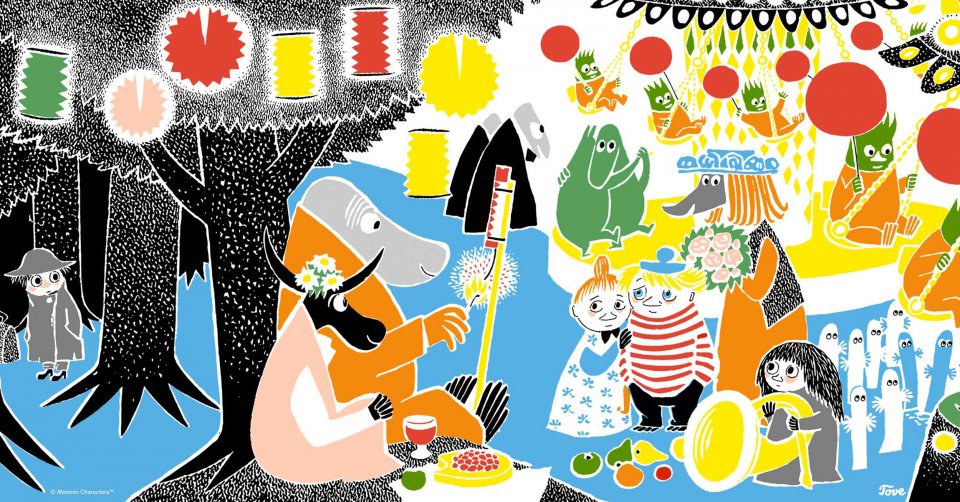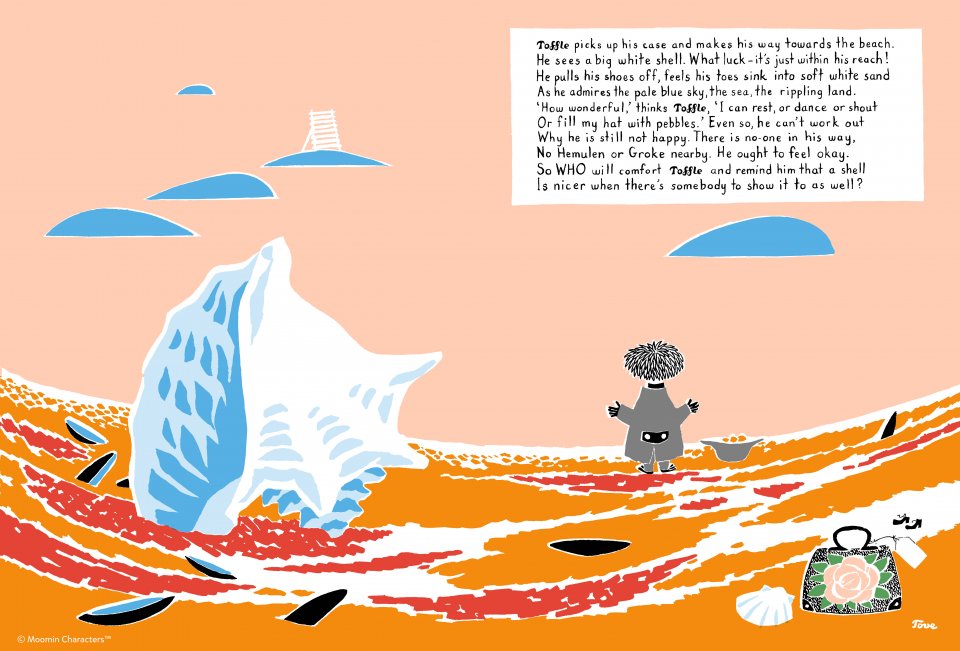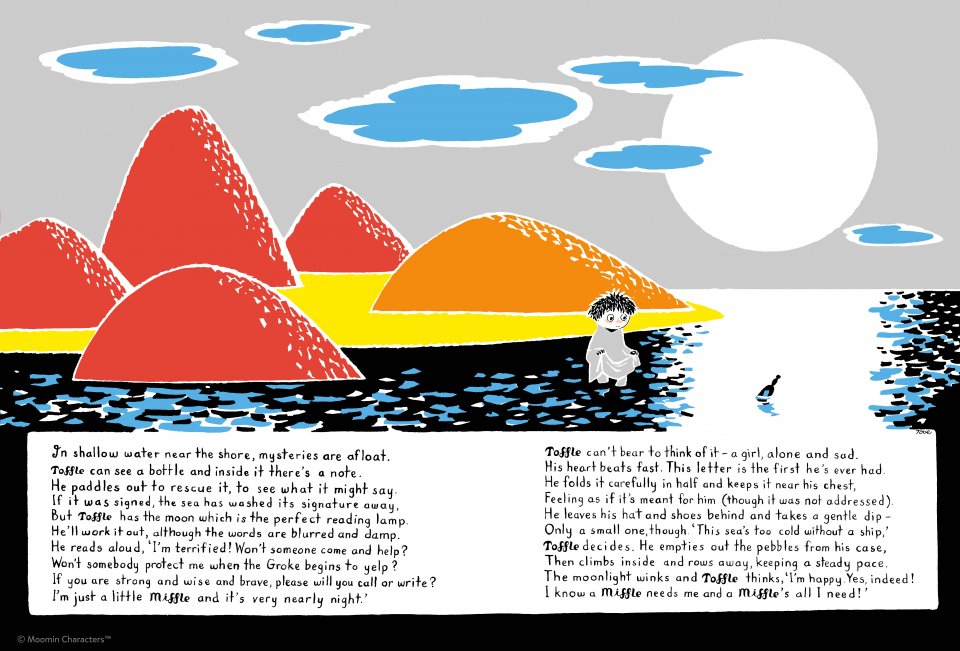Tove Jansson’s Who Will Comfort Toffle? is a therapeutic classic, loved by readers of all ages. In the Nordics, it is one of Tove Jansson’s most popular books and it has never been out of print since it was first published in 1960. Watch a mini-documentary about a book sure to steal your heart if you’ve ever felt lonely or afraid.
“Who Will Comfort Toffle? is about a state of mind that every single person on the planet sometimes finds themselves in”, says Sophie Hannah, a bestselling author and poet, who translated the book in 2010.
“When I first read it, I wasn’t a Toffle, I was feeling fine, but I could identify with that feeling of alienation, and slight discombobulation”, says Hannah.
A Moomin story without Moomins
Who Will Comfort Toffle? is set in Moominvalley, but doesn’t feature any Moomins. Instead, we meet Fillyjonks, jolly Hemulens, Mymble, Snufkin and a whole bunch of other characters. As Boel Westin says in her biography about Tove Jansson, it is the story of The Others.
The central figure is an introverted and lonely little creature called Toffle, who is too shy to speak to anyone – until he discovers a creature even more afraid than he.
“I think a great aspect of the Moomin world is that it cares for the little creatures, the ones who don’t have voices normally and the ones who aren’t being heroic”, says Natania Jansz, publisher at Sort of Books.
Tove Jansson cared deeply about the miffles and toffles of the world, the personalities lurking in the shadows, as she stated in an interview a few years after the book was published:
“If I’m addressing any particular sort of reader, I’m addressing a Miffle”
Who Will Comfort Toffle?
“An epic in verse”, is how Tove Jansson described the manuscript for the book to a friend. In Swedish, it consisted of 14 verses with 12 lines each. The pictures were drawn partly in Indian ink and partly as double spreads in colour. Her working title was “The Romantic Tale of the Lonely Toffle”.
A recurring phrase in the book, which is written in poetic rhyme, is “Who Will Comfort Toffle” – and at the outset, there seems to be no one around to do it. Toffle walks alone, lurking in the outskirts of a party in the woods, too shy to enter.
While Hemulen lights fireworks near the tall umbrella trees,
how lonely it must feel to be a Toffle no one sees.
So who will comfort Toffle and
explain the way things go?
They’d know that he was there,
if he would only say hello.
“It’s that classic trap of the shy child or shy person, who wants to be part of things but
just doesn’t know how to bridge that gap”, says Natania Jansz.
Different kinds of loneliness
“I think loneliness is handled really deftly in Who Will Comfort Toffle?, because it very cleverly shows all the different kinds of loneliness. There’s the loneliness when you’re on your own and there’s not a soul in sight and it’s dark and you’re scared. But then there’s also the loneliness when you’re at a busy, jolly, wild party and everyone else is having a great time and you’re just not, and you just feel completely isolated within a social community or event, says Sophie Hannah.
Natania Jansz points out how the books also show different approaches to being alone.
“You have this character who is miserable and lonely, unable to connect with the world, very unsure of himself. And this is loneliness. And in Snufkin, you have solitude chosen, a solitary character who’s self-assured and happy in his own skin”, says Jansz, describing the self-contained vagabond of Moominvalley, who doesn’t want to be tied down to anybody or anything.
What’s the point of a shell if you’ve got no one to show it to?
In one of the stunningly designed colour spreads of the book, Toffle finds himself on a beautiful beach and discovers a giant shell. But he can’t enjoy it, because he’s got no one to show it to.
Why is he still not happy. There’s no one in his way.
No Hemulen or Groke nearby. He ought to feel okay.
So Who will comfort Toffle and remind that a shell
Is nicer when there’s somebody to show it to as well?
“It’s heartbreaking to be in something so beautiful, but without being able to enjoy it. And that’s the depression of loneliness”, says Jansz.
Who will comfort Miffle?
At the beach, a turning point occurs. It arrives in the form of a message in a bottle, carried in front of Toffle’s bare feet by the glimmering sea. Just as in the first Moomin story, The Moomins and the Great Flood, where a message from Moominpappa arrives in a bottle, this bottle message is central to how the story develops.
Toffle reads the letter under the moon, a perfect reading lamp.
‘I’m terrified!
Won’t someone come and help?
Won’t somebody protect me when the Groke begins to yelp?’
If you are strong and wise and brave, please will you call or write?
I’m just a little miffle and it’s very nearly night.
Worrying about someone else
“Now he has someone else to worry about who isn’t him. So anyone who thought Toffle was self-indulgent at the beginning, suddenly, when he’s got somebody else whose aid he has to rush to, he feels so much better and immediately starts taking action”, says Sophie Hannah.
“That note gives him a mission and that’s actually when he becomes OK. That’s when he’s saved, really. I think what the story shows us is that it’s not the achieving of the goal and the getting of what you want that saves you. It’s realizing that you have a mission and that you’re prepared to do it and you’re going to go for it. And the striving and who you have to become to
even stand a chance of accomplishing it.”
Did you know that the story about Toffle and Miffle was inspired in part by a letter which Tove Jansson received from a young fan, who described himself as “one of those miserable little ones who are always on the outside”? You can find the touching backstory in the link below.
Read more about Tove Jansson and study her art in detail at www.tovejansson.com.

The touching story behind Who Will Comfort Toffle
Did you know that Tove Jansson’s iconic picture book Who Will Comfort Toffle was inspired by a letter from a young reader? The backstory:

The shadow of war in the first Moomin story
How much has the war influenced Tove Jansson’s first Moomin story? And what can it teach us on how family can also be chosen?

The first Moomin picture book was a praised breakthrough – how did Tove Jansson do it?
Curious about the first Moomin picture book? Watch our short documentary about the Book about Moomin, Mymble and Little My.

What The Invisible Child can teach us about empathy
Listen to the short story “The Invisible Child” read by Tove Jansson’s niece, Sophia Jansson, and reflect on its beautiful lessons.

Friendship and Love – a central message of Tove Jansson’s work
Do you know the most important Moomin values? Family and friends were always very important for Tove Jansson and are so for Moomins, too.

Celebrate friendship this Valentine’s Day – best Moomin gift ideas for friends
Celebrate friendship and surprise your loved ones with Moominous gifts this Valentine’s Day!




